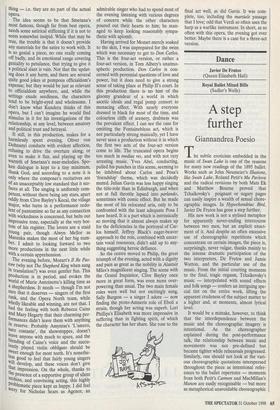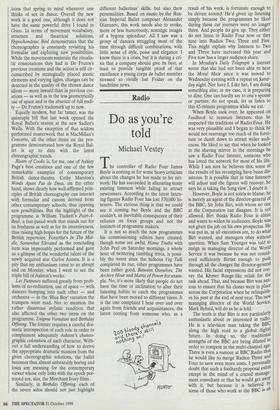Dance
Javier De Frutos (Queen Elizabeth Hall)
A step further
Giannandrea Poesio
The subtle eroticism embedded in the music of Swan Lake is one of the reasons for many new readings of the 1895 ballet. Works such as John Neumeier's Illusions, like Swan Lake, Roland Petit's Ma Pavlova and the radical revisions by both Mats Ek and Matthew Bourne proved that Tchaikovsky's poignant or sugary pages can easily inspire a wealth of sexual chore- ographic images. In Hypochondriac Bird, Javier De Frutos has gone a step further.
His new work is not a stylised metaphor for apparently never-ending intercourse between two men, but an explicit enact- ment of it. And despite an often excessive use of choreographic repetitions which concentrate on certain images, the piece is, surprisingly, never vulgar, thanks mainly to the intense dramatic participation of the two interpreters, De Frutos and Jamie Watton, and the particular use of the music. From the initial courting moments to the final, tragic orgasm, Tchaikovsky's music — interpolated with sound effects and folk songs — confers an intriguing spe- cial tint on the entire work, lifting the apparent crudeness of the subject matter to a higher and, at moments, almost lyrical level.
It would be a mistake, however, to think that the interdependence between the music and the choreographic imagery is intentional. As the choreographer explained during the post-performance talk, the relationship between music and movements was not pre-defined but became tighter while rehearsals progressed. Similarly, one should not look at the vari- ous choreographic quotations interspersed throughout the piece as intentional refer- ences to the ballet repertoire — moments from both Petit's Carmen and MacMillan's Manon are easily recognisable — but more as metaphorical unavoidable choreographic icons that spring to mind whenever one thinks of sex in dance. Overall the new work is a good one, although it does not have the same powerful drive I found in Grass. In terms of movement vocabulary, structure and theatrical solutions, Hypochondriac Bird demonstrates that the "choreographer is constantly revisiting his formulae and exploring new possibilities. While the movements maintain the ritualis- tic connotations they had in De Frutos's previous creations and the action is still cir- cumscribed by strategically placed scenic elements and varying lights, changes can be detected in the quality of the chosen dance idiom — more inward than in previous cre ations — as well as in the less geometrically use of space and in the absence of full nudi- ty — De Frutos's trademark up to now.
Equally modern, but far tamer, was the quintuple bill that last week opened the Royal Ballet's season at the new Sadler's Wells. With the exception of that seldom performed masterwork that is MacMillan's Concerto, all the other items on the pro- gramme demonstrated how the Royal Bal- let is up to date with the latest choreographic trends.
Room of Cooks is, for me, one of Ashley Page's best creations and one of the few remarkable examples of contemporary British dance-theatre. Cathy Marston's Words Apart Pas de Deux, on the other hand, shows clearly how well-affirmed prin- ciples of British choreography can interact with formulae and canons derived from other contemporary schools, thus opening new possibilities. But the highlight of the programme is William Tuckett's Puirt-A- Beul, a fast-paced work that stands out for its freshness as well as for its inventiveness, thus raising high hopes for the future of the British repertoire. Forsythe's In The Mid- dle, Somewhat Elevated as the concluding item was impeccably performed and gave us a glimpse of the wonderful talent of the newly acquired star Carlos Acosta. It is a pity that my enthusiasm came to an abrupt end on Monday, when I went to see the triple bill of Ashton's works.
Les Patineurs suffered greatly from prob- lems of co-ordination, use of space — with dancers bumping into each other — and orchestra — in the 'Blue Boy' variation the trumpets went mad. Not to mention the rather disastrous stylistic rendition that also affected the other two items on the programme, Enigma Variation and Birthday Offering. The former requires a careful dra- matic introspection of each role in order to complement adequately Ashton's choreo- graphic coloratura of each character. With- out a full understanding of how to derive the appropriate dramatic nuances from the given choreographic solutions, the ballet becomes thus almost unbearably boring and loses any meaning for the contemporary viewer whose only links with the epoch por- trayed are, alas, the Merchant Ivory films.
Similarly, in Birthday Offering, each of the seven solos should not just highlight
different ballerinas' skills, but also their personalities. Based on music by the Rus- sian Imperial Ballet composer Alexander Glazunov, this work needs also to evoke, more or less humorously, nostalgic images of a bygone splendour. All I saw was a group of dancers struggling most of the time through difficult combinations, with little sense of style, poise and elegance. I know there is a crisis, but it is during a cri- sis that a company should give its best, at least to provide tangible proof of that excellence a young corps de ballet member stressed so vividly last Friday on the lunchtime news.



















































































 Previous page
Previous page